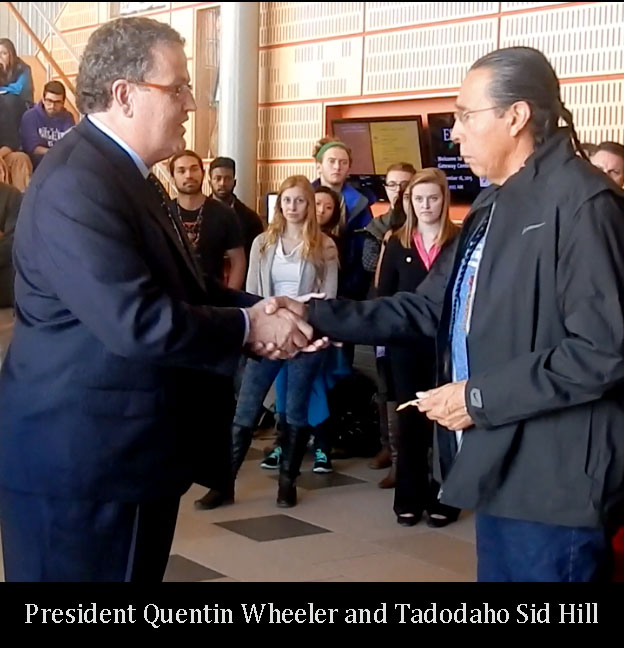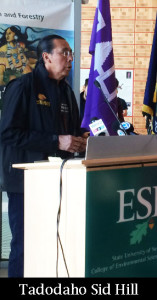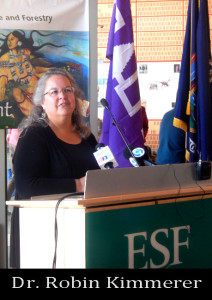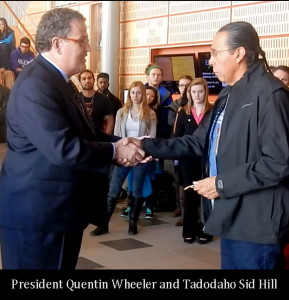
 Syracuse, NY— On Wednesday, November 18, 2015, the State University of New York College of Environmental Science and Forestry (SUNY-ESF) announced today that they were incorporating three statements into their regular communications and installing a stone monument that acknowledges that SUNY-ESF is on the lands of the Onondaga Nation. Tadodaho Sid Hill, and Clan Mothers Wendy Gonyea, Francine Lyons and Frieda Jacques were there to receive the acknowledgement, which was commemorated with a string of wampum beads presented to the Tadodaho by the President of SUNY-ESF, Dr. Quentin Wheeler.
Syracuse, NY— On Wednesday, November 18, 2015, the State University of New York College of Environmental Science and Forestry (SUNY-ESF) announced today that they were incorporating three statements into their regular communications and installing a stone monument that acknowledges that SUNY-ESF is on the lands of the Onondaga Nation. Tadodaho Sid Hill, and Clan Mothers Wendy Gonyea, Francine Lyons and Frieda Jacques were there to receive the acknowledgement, which was commemorated with a string of wampum beads presented to the Tadodaho by the President of SUNY-ESF, Dr. Quentin Wheeler.
“We have come together this morning to address an important question: where do we stand?” explained Dr. Robin Kimmerer, Director of SUNY-ESF’s Center for Native Peoples and the Environment. “SUNY ESF has been here for over 100 years… but our tenure here is just an eye blink in the history of these lands which have been and continue to be the homelands of the Onondaga people from time immemorial. Homelands which were rich in clean water, abundant forests, teeming wetlands, fertile soils, and a landscape that provided true wealth—the wealth of biodiversity and landscape and cultural integrity.”
She further stated, “The history which led to the displacement of the Onondaga people and dispossession of their homelands is a painful one which must be acknowledged and addressed… As an institution of higher education, we are committed to telling the truth, even when it comes with an uncomfortable history. It is necessary for healing.”
The three statements read:
- SUNY-ESF is located within the original territory of the Haudenosaunee, or Iroquois, Confederacy.
- The ESF main campus, its Heiberg Forest and its Lafayette Road Experimental Station are all located within the Land Rights Action of the Onondaga Nation.
- The Onondaga Nation maintains its own distinct government, language, and customs on a smaller portion of its original land base south of Syracuse.
“I am pleased to announce that beginning today, and every day forward, we will share similar statements with the thousands of visitors and students that we welcome to our campus each year,” stated SUNY ESF President Quentin Wheeler. “This represents a commitment to our intellectual inclusion, and our cultural pluralism on campus and it honors the very significant contributions of the Onondaga Nation to environmental leadership. These statements reflect too our gratitude for our past and current collaborations with the Nation and raise appropriate awareness of the Onondaga Nation’s Land Rights Action. These statements reinforce our responsibility to think about where we stand in the context of history, geography, and environmental understanding, so we are ever cognizant of the implications of our work for the real world… we stand on the side of responsible stewardship for the land. These simple statements are but a glimpse of a very complex history of the land, of its people, of its flora and fauna. It doesn’t speak about broken treaties, environmental degradation, important traditional knowledge, or the contributions of the Haudenosaunee peoples to the environment. Rather, they are intended to awaken curiosity. They are an invitation to inquiry and understanding, a reminder that our actions today are merely the latest in a continuum of actions.”
 Dr. Wheeler also announced that the school intended to memorialize this recognition of ancestral lands with a permanent stone monument to be placed on the ESF campus in the near future.
Dr. Wheeler also announced that the school intended to memorialize this recognition of ancestral lands with a permanent stone monument to be placed on the ESF campus in the near future.
“Shortly after my arrival in Syracuse in 2014 the Onondaga Nation extended the great honor to me to visit the longhouse. I am honored again today that you have joined me for this announcement of an initiative to recognize our location on your ancestral homelands.”
Tadodaho Sid Hill thanked President Wheeler and SUNY ESF for their words and the gift of wampum. “It’s very appropriate coming from ESF – the College of Environmental Science and Forestry – that you acknowledge publicly being on our traditional lands. With all the environmental issues going on today, it’s good that we all try to educate our people, the young people. The young people are the ones who will have to face climate change.”
Many of the speakers reflected on the responsibilities of humans with the environment.
“We recognize that we stand not only on Onondaga land but on the shoulders of indigenous environmental knowledge and wisdom,” observed Dr. Kimmerer. “We honor those contributions, in how we might understand the natural world and the place of humans in it. And in the spirit of reciprocity we offer the contributions of environmental science as a partner in this vital work for our common future.”
The Tadodaho noted, “We don’t have to go too far – look at the condition of Onondaga Lake, and our small stream that goes through the Nation, which our people don’t use much any more because of the salt mining. There’s a lot of issues right here to study about, to learn about. I was just recently in Sweden… they turned things around in the 1970s. Now they can eat the fish, the water is good in Stockholm. You have the technology, the spirit, and I know you young people have the energy – that’s what you have to use, positively, for the next generations.”
“As students we often hear about the Onondaga Nation from our professors or in a classroom,” reflected Margaret Foley, President of SUNY ESF’s Undergraduate Student Association. “Now, in addition to being taught about that connection in a classroom, we will be reminded of our connection to the Haudenosaunee every time we hear our President speak, or walk across our new quad.”
She noted that earlier in November, the undergraduate student association had also passed a resolution urging the ESF community, Syracuse University, and the State of New York to recognize Indigenous Peoples’ Day as a holiday.
“It not only acknowledges our desire to recognize the indigenous people in our community but to recognize our campus stands on lands of the Onondaga Nation. Today, and from this day forward, we recognize that that land still belongs to those people. On behalf of the undergraduate student population, we hope that this is the first of many steps to recognize the Haudenosaunee and the Onondaga Nation here on campus.”
“Ten years ago the Chiefs and Clan Mothers directed us to include the first paragraph in the Land Rights action that called for healing,” reflected Joseph Heath, General Counsel for the Onondaga Nation, in remarks after the press conference. “Healing of the environmental destruction and devastation and disrespect for their lands and waters, and the healing among the settlers who have come to live on their land. And these steps by SUNY-ESF today are a clear reflection of how well that message has been received in the Central New York community.”
The announcement was followed by an event hosted by the Center for Native Peoples and the Environment in which the students brainstormed, with some input from Onondaga Nation representatives in attendance, how they can be good allies for the environment.
